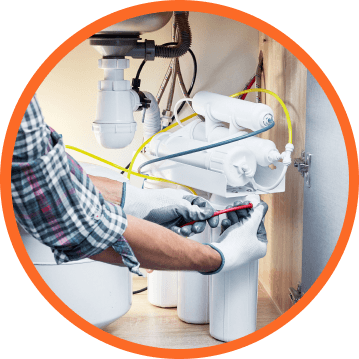How Does Reverse Osmosis Work?
Reverse osmosis is a water filtration process that removes impurities by forcing water through a semipermeable membrane. This process captures contaminants like lead, chlorine, and even microscopic particles that can affect taste, smell, and safety. For homeowners in Layton, where water often contains minerals and sediments, an RO system can make a noticeable difference in water quality.
Imagine your water acting as a highway, carrying everything from dirt and bacteria to dissolved salts. The RO system acts as a series of toll booths, letting only pure water molecules pass through. This results in cleaner, healthier water that tastes better and is safer for your family.
It’s not just about drinking water, either—an RO system can protect your plumbing from mineral buildup, extend the life of your fixtures and appliances such as water heaters, boilers, garbage disposals, etc, and make your home a more efficient and healthier place to live.
Here’s a quick breakdown of how RO systems work.
Pre-filtration
The pre-filtration stage is where the heavy lifting begins. This component is designed to remove large particles, sediment, rust, and debris from your water before it reaches the reverse osmosis membrane. Think of it as a gatekeeper, protecting the more delicate parts of the system from premature wear.
Pre-filters are particularly important in Layton, UT, where water often contains high levels of sediment due to local geology and municipal water processing. Without a functioning pre-filter, sediment could clog the RO membrane, drastically reducing its lifespan.
Regularly replacing pre-filters ensures the system operates efficiently and maintains optimal water quality.
Carbon filtration
After the pre-filtration stage, water flows through a carbon filter, which targets chlorine, chloramines, and other chemical contaminants. These substances not only affect water quality but can also damage the RO membrane over time.
Carbon filtration is a game-changer for taste and odor. Many Layton homeowners notice a significant improvement in their water after installing an RO system with a quality carbon filter. By removing chlorine and volatile organic compounds (VOCs), the carbon filter ensures your water is not only safe but also refreshing.
However, over time, these filters can become saturated and lose effectiveness, so replacing them as recommended by the manufacturer is crucial for consistent performance.
Reverse osmosis membrane
The reverse osmosis membrane is the powerhouse of the system. This semi-permeable barrier removes the tiniest impurities, including dissolved solids, heavy metals, bacteria, and viruses.
Water is forced through the membrane, leaving contaminants behind. Without a functioning membrane, your system won’t effectively reduce TDS levels, compromising water quality.
It’s worth noting that RO membranes are delicate and require specific water pressure to operate correctly. Low pressure can reduce performance, while excessive pressure may damage the membrane. This is where professional servicing comes in handy. Our team can test your system’s pressure and make necessary adjustments.
Post-filtration
Once water has passed through the RO membrane, it undergoes post-filtration. This final stage enhances the taste and quality of the water, ensuring it’s free from any remaining impurities.
The post-filter, often made of carbon, acts as a finishing touch. It removes any lingering odors, tastes, or particles that may have escaped earlier stages. For families in Layton who use reverse osmosis water for cooking, drinking, and even watering plants, post-filtration ensures that every drop meets the highest standards.
Like other filters in the system, post-filters require regular replacement. Neglecting this step can lead to a decline in water quality, defeating the purpose of your RO system.


Rare Breed came out for my water heater that flood my home. They were able to come out same day and give me options on what I could do since the water heater needed to be replaced. They helped clean up the flood and made the stressful situation and easy as possible. They really are “the herd you can trust”